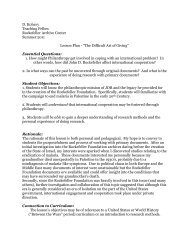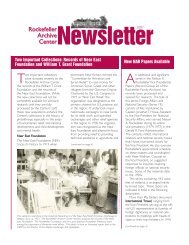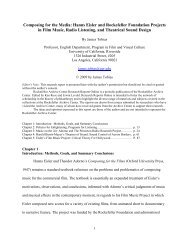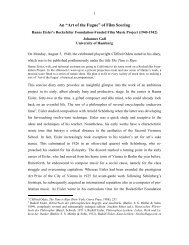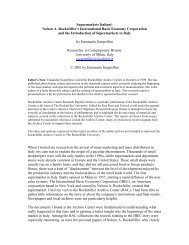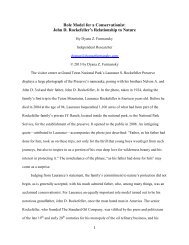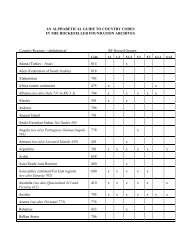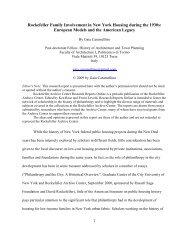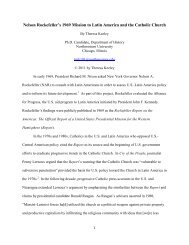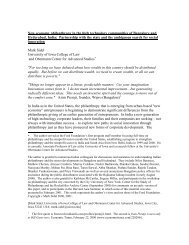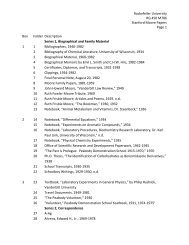Inter-American Rural Youth Program - The Rockefeller Archive Center
Inter-American Rural Youth Program - The Rockefeller Archive Center
Inter-American Rural Youth Program - The Rockefeller Archive Center
You also want an ePaper? Increase the reach of your titles
YUMPU automatically turns print PDFs into web optimized ePapers that Google loves.
<strong>The</strong> <strong>Program</strong>a <strong>Inter</strong>americano para la Juventud <strong>Rural</strong><br />
(<strong>Inter</strong>-<strong>American</strong> <strong>Rural</strong> <strong>Youth</strong> <strong>Program</strong>) and<br />
<strong>Rural</strong> Modernization in Cold War Latin America<br />
By Gabriel N. Rosenberg<br />
Visiting Assistant Professor<br />
Department of History<br />
Duke University<br />
Durham, North Carolina<br />
rosenberg.gabriel@gmail.com<br />
© 2011 by Gabriel N. Rosenberg<br />
This article explores the 4-H agricultural youth clubs that flourished in Latin America<br />
between 1960 and 1975. It places those clubs within the broader context of the<br />
internationalization of <strong>American</strong> agricultural extension and economic hegemony in the Global<br />
South during the decades following World War II. In the three decades before World War II,<br />
fifteen million rural <strong>American</strong> youth and several hundred thousand adult volunteers participated<br />
in 4-H agricultural and homemaking clubs administered by the United States Department of<br />
Agriculture (USDA). Organized by experts from land grant colleges and the USDA and partially<br />
funded by agricultural and financial firms, 4-H clubs educated rural youth on a host of topics: the<br />
labor and technology of “modern” agricultural and home making, the appropriate divisions of<br />
gendered labor in “farm families,” the cultivation of healthy bodies, and the meanings of<br />
“citizenship” in democratic societies. 1 After World War II, the USDA developed similar clubs<br />
around the globe in coordination with the United States military and NGOs like the 4-H<br />
Foundation and Nelson A. <strong>Rockefeller</strong>'s <strong>American</strong> <strong>Inter</strong>national Association for Economic and<br />
Social Development (AIA). This article focuses on 4-H programs in Latin America administered<br />
by the AIA-financed <strong>Program</strong>a <strong>Inter</strong>americano para la Juventud <strong>Rural</strong> (PIJR), or “<strong>Inter</strong>-<br />
1
<strong>American</strong> <strong>Rural</strong> <strong>Youth</strong> <strong>Program</strong>.”<br />
Following World War II, the USDA exported systems of agricultural extension abroad to<br />
both reconstruct war-torn landscapes and to create a global class of rural “democratic” citizens.<br />
To help create functional agricultural extension networks abroad, the USDA maintained a<br />
training school for foreign extension workers in Beltsville, Maryland. Initially, the program was<br />
jointly administered by the USDA and the State Department's Institute of <strong>Inter</strong>-<strong>American</strong> Affairs<br />
and it was designed to promote “the improvement of farming efficiency, living standards, and<br />
health of rural people” in Central and South America only. <strong>The</strong> initial class of seventy-eight<br />
trainees from twelve Latin <strong>American</strong> nations received intensive instruction in extension methods,<br />
with many living and working with county agents in rural communities in what the program<br />
referred to as “in-service” training. 2<br />
In 1944, the USDA took exclusive responsibility for the<br />
program, made it available to extension workers from all over the world, and renamed it the<br />
Foreign Training Division. Before 1950, over six-hundred foreign nationals graduated from the<br />
program and returned to their native countries to establish or expand extension systems. 3<br />
By<br />
1960, FTD graduates numbered six-thousand from over one-hundred countries on every<br />
inhabited continent. Between 1950 and 1970, FTD-trained extension workers labored in nearly<br />
every one of the battlefields of the Global Cold War: Korea, Cuba, Taiwan, Colombia, El<br />
Salvador, the Philippines, and scores of others. 4<br />
In each location, FTD-trained workers also organized 4-H organizations, frequently with<br />
the assistance of the U.S. military apparatus. 4-H organizations sprouted across Asia and the<br />
Pacific Rim in every nation with a sustained <strong>American</strong> military presence, including Korea,<br />
Vietnam, Japan, and the Philippines. In Korea, Colonel Charles Anderson, the military governor<br />
of Kyunggi Province, first established 4-H clubs in 1947 before turning the organization over to<br />
2
Korean extension workers. Korean 4-H expanded “at a remarkable rate” using “<strong>American</strong><br />
resources and Korean initiative,” historian Gregg Brazinsky explains. <strong>The</strong> United States<br />
Operations Mission to Korea directed financial and technical support to the clubs. By 1967,<br />
760,000 Korean youth enrolled and recited the official creed: “I believe in my country, my<br />
province and my community and in my responsibility for their development.” 5<br />
In Central and<br />
South America, FTD graduates founded 4-H organizations (usually called 4-S, 4-F or 4-C clubs)<br />
in nearly every nation. Through the 1950s, however, most of these organizations were haphazard<br />
affairs, enrolling only a few thousand members and culling support almost exclusively from<br />
respective national Ministries of Agriculture. By the early 1960s, the USDA claimed, “<strong>The</strong>re are<br />
76 countries with 4-H or 4-H-type organizations,” enrolling over 6.3 million youth worldwide,<br />
including more than 4 million youth outside of the U.S.. 6<br />
Howard Law, an <strong>American</strong> international development technician working in Venezuela,<br />
identified the paucity of support for youth club work as a major obstacle for successful rural<br />
development throughout Latin America. Law, a former rural credit supervisor in the New Deal<br />
USDA, spent most of the 1950s directing the Consejo de Bienestar <strong>Rural</strong>, a Venezuelan rural<br />
development agency financed by the AIA. 7<br />
In Venezuela, the Ministry of Agriculture had been<br />
running agricultural youth clubs since the late 1930s, called 5-V clubs, modeled after <strong>American</strong><br />
4-H clubs. FTD graduates had expanded the program in the 1950s, but budget problems and a<br />
lack of attention to rural development in general had stymied Venezuelan club-work. 8 Through<br />
his related rural development work, Law became increasingly familiar with 5-V and convinced<br />
of its potential. Echoing Wilson's conception of youth as agents of a development “from within,”<br />
Law wrote that young Venezuelans involved in 5-V clubs carried “new ideas into the home – a<br />
transmission that is often possible in no other way.” 9<br />
However, Law worried that 5-V's over-<br />
3
eliance on government agencies limited its growth and departed too substantially from<br />
<strong>American</strong> 4-H's tested model of public-private hybridity. With ample private corporate and<br />
philanthropic support, Law maintained that 5-V clubs could more successfully train “the<br />
individual in modern agricultural practices, in homemaking, in the fundamental credit and sound<br />
business practices and, perhaps most heartening of all, in the orderly democratic process of<br />
solving group problems.” 10 To that end, Law lobbied the AIA for funds to establish an<br />
independent National 5-V Foundation, which would gather financial support from the domestic<br />
and international business community, including “General Motors, Ford, several tractor<br />
companies, General Electric, Westinghouse, Sears, fertilizer companies, oil companies, tire<br />
companies and many others.” 11<br />
With AIA support, Law scaled upward from Venezuela. In 1960, Law received funding<br />
from the AIA and the <strong>Inter</strong>-<strong>American</strong> Institute of Agricultural Sciences to create an umbrella<br />
organization for Latin <strong>American</strong> 4-H clubs. 12<br />
Based in the Costa Rican offices of the Institute,<br />
the PIJR soon opened additional regional offices in Brazil and Venezuela run by extension<br />
specialists Santiago Apodaca and Edgar Matta. From those offices, the PIJR sought to knit the<br />
inchoate and underfunded Latin <strong>American</strong> rural youth clubs into an efficient, well-funded,<br />
transnational movement. To accomplish this goal, the PIJR launched a series of initiatives. First,<br />
in each nation, the PIJR lobbied for legislation and gathered supporters for a private foundation<br />
that could raise funds and supplement the activities of the Ministries of Agriculture. Second, the<br />
PIJR also raised funds for member organizations directly and assisted with grant applications.<br />
Third, the PIJR ran training workshops for extension staff and volunteer youth club leaders.<br />
Lastly, the PIJR organized international 4-H competitions and exchanges designed to award<br />
outstanding club work and to garner positive attention for the member organizations. <strong>The</strong> sum of<br />
4
these activities paid rapid dividends. Club work in South and Central America grew from fewer<br />
than 50,000 members in 1960 to more than 250,000 by 1967. 13<br />
<strong>The</strong> PIJR promoted a particular brand of “grassroots” rural development that connected<br />
rural youth to international sources of capital and technology. <strong>The</strong>y designed this method to<br />
bypass both resistant rural adults and fickle Ministries of Agriculture. Law explained how this<br />
process worked in practice by describing an experimental youth club program in rural Uruguay.<br />
Extension specialists affiliated with the PIJR and <strong>Inter</strong>-<strong>American</strong> Institute of Agricultural<br />
Sciences selected a small “pilot zone” south of Montevideo where the “soil was fair to poor” and<br />
“the people had a reputation of resisting change.” <strong>The</strong> specialists then assumed control of an<br />
existing but dysfunctional youth club in the community, Movimiento de la Juventud Agraria.<br />
<strong>The</strong>y retained the teachers who led it but gave them special training in “democratic” leadership<br />
that would “guide them away from being autocratic.” In addition, they introduced the members<br />
to a hybrid corn project and provided them with access to hybrid seed and fertilizer. <strong>The</strong><br />
winning contestants produced an astounding yield of over 5000 kilograms per hectare. “This had<br />
its effect on the farmers,” explained Law. “It was...the 'softening up' of the resistance, the<br />
entrance to the farmers...<strong>The</strong> youth with the highest yield had parents that were completely<br />
against the use of hybrid seed. His success convinced them to his side.” In addition to<br />
introducing hybrid corn to the region, Law maintained that the project also had a salutary effect<br />
on the community's politics. Rather than blaming industrialists, landowners, and middlemen for<br />
their poverty, “the farmers and homemakers have already begun to take responsibility for solving<br />
their own problems.” Indeed, Law continued, “from inside the home (the youth of the family in<br />
club work) it has been possible to overcome prejudices that the agent couldn't combat directly.” 14<br />
Although PIJR technicians described this sort of development as “free from political<br />
5
overtones,” their ambitions to produce robust “rural citizenship” implicitly criticized<br />
revolutionary programs that threatened property rights and foreign investment. 15 <strong>The</strong> AIA<br />
maintained that political instability was a “strong deterrent” for economic growth and blamed the<br />
“history of political strife” in many Latin <strong>American</strong> countries for the absence of both foreign and<br />
domestic investment. 16<br />
Ironically, it also ascribed poverty in rural communities to ignorance,<br />
complacent farming techniques, and a nebulous “resistance to change.” 17<br />
It was suggested, then,<br />
that the problems of Latin America were paradoxically rooted in both too much and too little<br />
stability. Although the PIJR tended to replicate those somewhat contradictory assumptions, it<br />
also suggested that the “pliability of youth” offered international development agencies a middleway<br />
between political radicalism and stagnant agriculture. 18 As Law explained, the cultivation<br />
of future rural “leaders and citizens” could solve a host of problems, from “poor health” to<br />
“primitive agricultural practices.” 19<br />
“Leaders and citizens,” unlike radicals and revolutionaries,<br />
found ways to spur economic growth and solve community problems that were constructive –<br />
rather than destructive – and amenable to private property and commercial exchange. <strong>The</strong> club<br />
literature created by the PIJR presented citizenship as a fundamental goal of club work and<br />
argued that the uniquely deliberative, cooperative model of the clubs would enable members to<br />
be “utiles a la sociedad y perpetuar la democracia” (“useful to society and to perpetuate<br />
democracy”). 20<br />
Law and the other PIJR technicians explicitly contrasted this approach to<br />
development with expensive brick-and-mortar infrastructure projects and they claimed that only<br />
human investment could provide the “citizens” necessary for continued “economic and social<br />
improvement. “Great sums of money have been spent in capital outlay for 'things,'” complained<br />
a 1964 PIJR Report. “Are we dedicating a proportionate share of investment capital in rural<br />
people?” 21<br />
6
However, Law and the other specialists at the PIJR also reasoned that creating direct<br />
relationships between international capital and rural youth fostered concrete support for their<br />
favored model of commercial agribusiness above and beyond what anti-communist<br />
indoctrination could accomplish. For this reason, the PIJR concentrated intently on expanding<br />
credit facilities for club members. <strong>The</strong> PIJR solicited funds from various international sources,<br />
but left the loans to be jointly administered by the national club foundations and the various<br />
extension services. Participating entities were a diverse lot, but they shared a commitment to<br />
U.S. hegemony and commercial agribusiness development. Major <strong>American</strong> banks including<br />
Bank of America and Chase Manhattan offered loans, as did national banks and the <strong>Inter</strong>-<br />
<strong>American</strong> Development Bank. <strong>The</strong> following large multinational corporations, seeking new<br />
customers in Latin America, contributed funds and therefore provided significant support: Sears,<br />
Eli Lilly, Purina, Esso, Ford, General Mills, and <strong>Inter</strong>national Harvester. <strong>The</strong> charitable<br />
foundations of those corporations – the Sears Foundation, the Ford Foundation, and the Johnson<br />
Foundation – also contributed monies. Finally, the U.S. government channeled support directly<br />
through USAID and indirectly through the thicket of development agencies it subsidized. In<br />
addition, by the mid-1960s, the PIJR also worked with several national governments and the U.S.<br />
State Department to establish “4-H Peace Corps Projects” throughout Latin America. 4-H Peace<br />
Corps projects placed U.S. nationals with experience in club work in rural Latin <strong>American</strong><br />
communities where they would organize and supervise youth credit projects funded by USAID<br />
and U.S. based corporations. 22<br />
Of course, these credit projects gave rural youth first-hand<br />
experience with agribusiness financial instruments. But by focusing on rural youth, such<br />
projects also provided conceptual and practical terrain to coordinate and intertwine the host of<br />
private and public international actors. In this sense, the rural youth became the fulcrum about<br />
7
which a vast array of developers pivoted.<br />
Similarly, although support from Latin <strong>American</strong> Ministries of Agriculture was precarious<br />
and inconstant, the PIJR drew public support and applause from a number of prominent centerleft<br />
Latin <strong>American</strong> politicians. Such nationalist social democrats occupied a precarious middleground<br />
between the anti-democratic right and the anti-capitalist left. This middle ground often<br />
entailed ambitious modernization programs, opening economies to foreign investment, and<br />
expanded social spending – all policies which were designed to both alleviate the poverty that<br />
fed communist insurgencies, while protecting property rights and capital investment. As such,<br />
figures like Juscelino Kubitschek, Rómulo Betancourt, Jose Figueres, and Galo Lasso traded<br />
support with both the United States government and the same multinational corporations that<br />
invested in rural youth through the PIJR. This dynamic was especially evident in Brazilian 4-S<br />
clubs. 4-S clubs originated first in the Brazilian state of Minas Gerais in 1952 as one of the<br />
schemes of a rural credit organization funded by the AIA. When Minas Gerais governor<br />
Kubitschek ascended to the Brazilian presidency in 1956, he nationalized the credit organization,<br />
renamed it the Associacao Brasileira de Credito e Assistencia <strong>Rural</strong> (ABCAR), and placed the<br />
now-national 4-S clubs under its control. 23<br />
In December of 1961, Kubitschek, then the expresident,<br />
accepted a position on the PIJR Executive Committee, along with Nelson <strong>Rockefeller</strong>,<br />
Figueres, ABCAR president Joao Napoleao de Andrades, Betancourt's Secretary of Health and<br />
Social Assistance, Arnoldo Gabaldon, and U.S. Secretary of Agriculture, Orville Freeman. 24<br />
Although Latin <strong>American</strong> 4-H achieved steadily increasing enrollments and high<br />
visibility over the course of the 1960s, the PIJR could not survive the AIA's dissolution in 1968.<br />
In December of 1967, the AIA transferred administrative responsibility of the PIJR to the U.S.<br />
based National 4-H Foundation. Under the new arrangement, the AIA would also phase out<br />
8
funds to the PIJR with the expectation that the National 4-H Foundation and external grants<br />
would more than compensate for the lost monies. Initially, this arrangement permitted the PIJR<br />
to continue to operate. In 1970, Howard Law stepped down as the PIJR director, and turned the<br />
reins of the organization over to <strong>The</strong>odore Hutchcroft, another <strong>American</strong> development specialist.<br />
In the same year, the PIJR won four-year grants from the W. K. Kellogg Foundation and the<br />
<strong>Rockefeller</strong> Brothers Fund (RBF). When they expired, both Kellogg and the RBF declined to<br />
renew the grants. Hutchcroft desperately tried to secure new funding, but, in 1975, the PIJR<br />
closed its doors. Without the PIJR's fundraising and coordinating work, the various Latin<br />
<strong>American</strong> 4-H organizations slowly fell into disarray and dissolved. 25<br />
Editor's Note: This research report is presented here with the author’s permission but should not be cited<br />
or quoted without the author’s consent.<br />
<strong>Rockefeller</strong> <strong>Archive</strong> <strong>Center</strong> Research Reports Online is a periodic publication of the <strong>Rockefeller</strong> <strong>Archive</strong><br />
<strong>Center</strong>. Edited by Erwin Levold, Research Reports Online is intended to foster the network of scholarship<br />
in the history of philanthropy and to highlight the diverse range of materials and subjects covered in the<br />
collections at the <strong>Rockefeller</strong> <strong>Archive</strong> <strong>Center</strong>. <strong>The</strong> reports are drawn from essays submitted by researchers<br />
who have visited the <strong>Archive</strong> <strong>Center</strong>, many of whom have received grants from the <strong>Archive</strong> <strong>Center</strong> to<br />
support their research.<br />
<strong>The</strong> ideas and opinions expressed in this report are those of the author and are not intended to represent<br />
the <strong>Rockefeller</strong> <strong>Archive</strong> <strong>Center</strong>.<br />
9
ENDNOTES:<br />
1 See Gabriel N. Rosenberg, “Breeding the Future: <strong>The</strong> <strong>American</strong> 4-H Movement and the Roots of the Modern <strong>Rural</strong><br />
World, 1914-1948.” Ph.D. dissertation, Brown University, Providence, Rhode Island, 2011.<br />
2 “Training <strong>Program</strong> in Extension Methods For Latin <strong>American</strong>s,” September 1944, p. 1, Box 12, “<strong>Inter</strong>national 4-H<br />
<strong>Program</strong>s, Volume 1,” 4-H Series, Records of the Cooperative Extension Service, Record Group (RG) 33, National<br />
<strong>Archive</strong>s, College Park, Maryland, (hereafter NACP1).<br />
3 “Quadrennial,” Trainee Trails, November 7, 1949, p.1, “<strong>Inter</strong>national 4-H <strong>Program</strong>s, Volume 1,” Box 12, NACP1.<br />
4 “Trainees Worldwide,” Trainee Trails, April 1958, p. 1, “<strong>Inter</strong>national 4-H <strong>Program</strong>s, Volume 1,” Box 12, NACP1.<br />
5 Gregg Brazinsky, Nation Building in South Korea: Koreans, <strong>American</strong>s and the Making of a Democracy. Chapel<br />
Hill, North Carolina: University of North Carolina Press, 2009, pp. 209-217.<br />
6 “<strong>The</strong> 4-H Idea Around the World,” circa 1960, p. 6, “<strong>Inter</strong>national 4-H <strong>Program</strong>s, Volume 1,” Box 12, NACP1.<br />
7 “Announcement,” March 2, 1970, Folder 199, Box 25, Series B, RG 4, <strong>Rockefeller</strong> Family <strong>Archive</strong>s, <strong>Rockefeller</strong><br />
<strong>Archive</strong> <strong>Center</strong>, Sleepy Hollow, New York (hereafter, RFA-RAC). For this history of the AIA see Darlene Rivas,<br />
Missionary Capitalist: Nelson <strong>Rockefeller</strong> in Venezuela. Chapel Hill: University of North Carolina Press, 2002.<br />
8 See also “Organizacion, Funcionamientoy Actividades de la Sociedad Civil Pro-Clubes 5-V de Venezuala,” PIJR<br />
October/December 1962 Quarterly Report, 1962, Folder 270, Box 35, AIA-RAC.<br />
9 Howard Law, “A Venezuelan 5-V Foundation,” December 1957, p. 1, Folder 100, Box 10, RG 4, Series B, RFA-<br />
RAC.<br />
10 Law, “A Venezuelan 5-V Foundation,” p. 1.<br />
11 Ibid., p. 5.<br />
12 PIJR January/March Quarterly Report 1960, 1960, pp. 1- 3, Folder 255, Box 33, AIA-RAC.<br />
13 For a useful breakdown see “<strong>The</strong> 1964 Report of <strong>Rural</strong> <strong>Youth</strong> Club <strong>Program</strong>s in the Americas: Part I of the<br />
Proceedings of the 1964 <strong>Inter</strong>-<strong>American</strong> <strong>Rural</strong> <strong>Youth</strong> Leaders' Conference,” 1964, p. 4, Folder 101, Box 10, Series<br />
B, RG 4, RFA-RAC.<br />
14 Howard Law, “Talk Given by Howard E. Law at South <strong>American</strong> Extension Conference, Bogota, Colombia July 2<br />
to 15, 1961,” PIJR July/September Quarterly Report 1961, 1961, Folder 259, Box 33, AIA-RAC.<br />
15 Law, “A Venezuelan 5-V Foundation,” p. 2.<br />
16 “<strong>American</strong> <strong>Inter</strong>national Association for Economic and Social Development: Proposal for Future Support of <strong>Rural</strong><br />
Development in Latin America,” December, 1963, p. 36, Folder 288, Box 30, Series B, RG 4, RFA-RAC.<br />
17 “<strong>The</strong> 1964 Report of the <strong>Rural</strong> <strong>Youth</strong> Club <strong>Program</strong>s in the Americas,” p. 2.<br />
18 Law, “Talk Given by Howard E. Law at South <strong>American</strong> Extension Conference, Bogota, Colombia July 2 to 15,<br />
1961,” p. 3.<br />
19 Howard Law, “Talk on the Present Situation and the Potential for the <strong>Rural</strong> <strong>Youth</strong> Work in Latin America,” PIJR<br />
October/December Quarterly Report 1960, 1960, pp. 2-9, Folder 255, Box 33, AIA-RAC.<br />
20 “Los Clubes 4-S y la Democracia,” La Carreta in Exhibits of PIJR January/March Quarterly Report, 1964, p.1,<br />
Folder 280, Box 37, AIA-RAC.<br />
21 “<strong>The</strong> 1964 Report of the <strong>Rural</strong> <strong>Youth</strong> Club <strong>Program</strong> in the Americas,” p. 1.<br />
22 See “Proposed Brazil 4-S Club Peace Corps Project,” PIJR April/June Quarterly Report 1961, 1961, Folder 258,<br />
Box 33, AIA-RAC.<br />
23 For more on AIA, ABCAR, and Kubitschek, see Margaret B. Boardman, “<strong>The</strong> Man, <strong>The</strong> Girl and the Jeep AIA:<br />
Nelson <strong>Rockefeller</strong>'s Precursor Non-Profit Model for Private U.S. Foreign Aid,” Mexico and the World 6: 1 (Winter<br />
2001) and Elizabeth Ann Cobbs, <strong>The</strong> Rich Neighbor Policy: <strong>Rockefeller</strong> and Kaiser in Brazil. New Haven,<br />
Connecticut: Yale University Press, 1992.<br />
24 OAS Press Release, December 22, 1961, Folder 885, Box 93, Series L, RG 4, RFA-RAC.<br />
25 See PIJR Quarterly Report October/December 1967, p. 1, Folder 303, Box 40, AIA-RAC; “<strong>Rockefeller</strong> Brothers<br />
Fund, Minutes of Meeting of the Executive Committee,” October 19, 1970, Folder 3481, Box 579, RG 3.1,<br />
<strong>Rockefeller</strong> Brothers Fund <strong>Archive</strong>, <strong>Rockefeller</strong> <strong>Archive</strong> <strong>Center</strong>, Sleepy Hollow, New York (hereafter RFB-RAC);<br />
<strong>The</strong>odore Hutchcroft, letter to Moody, October 28, 1975, Folder 3490, Box 579, RG 3.1, RFB-RAC.<br />
10



